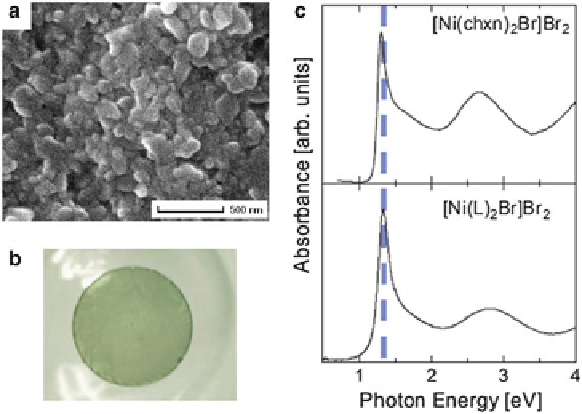Chemistry Reference
In-Depth Information
Fig. 7.10 (a) SEM image of nanocrystals of [Ni(
L
)
2
Br]Br
2
.(b) Photograph of a [Ni(
L
)
2
Br]Br
2
/
PMMA film. (c) Absorption spectra of a single crystal of [Ni(chxn)
2
Br]Br
2
(
upper panel
) and a [Ni
(
L
)
2
Br]Br
2
/PMMA film (
lower panel
). Adapted from [
5
]
Ni-Cl-Cl and ~2.15 eV in Ni-Cl-NO
3
are the strong evidences for the higher-lying
odd-parity state |3
.
Since the higher-lying odd-parity state |3
>
>
corresponds to the band-edge, the
energy difference between |3
is a crude measure
of the binding energy
E
b
of the lowest excitonic state. In Ni-Br-Br,
E
b
evaluated
from the difference is about 90 meV. The magnitude of
E
b
increases as Ni-Br-Br
<
>
and the lowest exciton state |1
>
<
DE
between
Ni-Cl-Cl
Ni-Cl-NO
3
in Ni-X chain compounds. The splitting
>
>
|1
also increases in this order. This tendency is also observed in the ER
studies as mentioned above. In Ni-Br-Br, the small excitonic effect makes two CT
excited states (|1
and |2
) almost degenerate, leading to the large transition dipole
moment between |1
>
and |2
>
and therefore to the large
w
>
and |2
>
(3)
.
7.3.3 Z-Scan Measurements [
5
]
When we consider the application of the nonlinear optical materials to ultrafast
optical switching devices using, for example, optical waveguides, fabrication of a
thin film sample is necessary. Recently, the fabrication of high-quality thin films of
the Ni-X compound was successfully made, in which nanocrystals of a Ni-X
compound, [Ni(
L
)
2
Br]Br
2
(
L
:1,2-diaminohexadecane), having long alkyl chains
(C
14
H
29
) shown in Fig.
7.1b
were dispersed in an optical polymer (PMMA
¼
poly(methyl methacrylate)). Size of a nanocrystal is typically ~100 nm wide and
a few tens of nanometers thick as seen in the scanning electron microscopy (SEM)

Search WWH ::

Custom Search